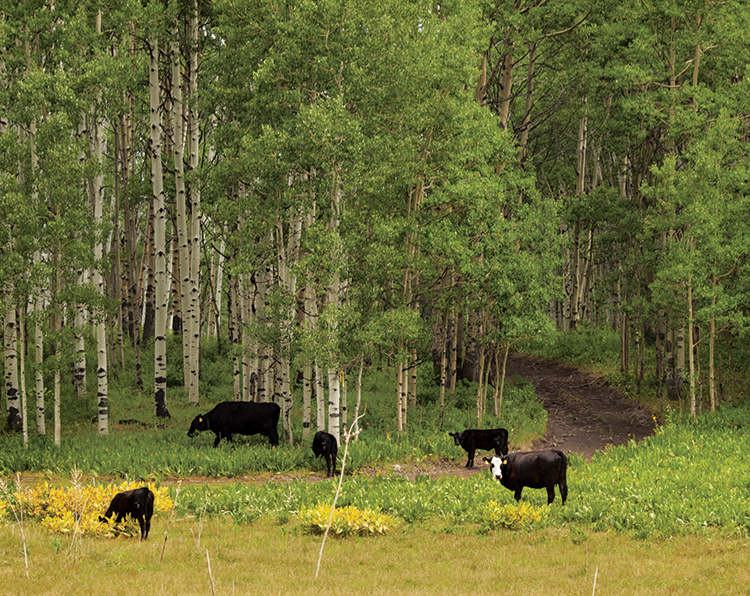Home > Colorado > Colorado Crops & Livestock > Colorado Cattle Feast on the Forest Floor
Colorado Cattle Feast on the Forest Floor
In partnership with: Colorado Department of Agriculture

Colorado’s beautiful and expansive landscape contains close to 24.5 million acres of forested land – a little more than one-third of the state – and consists of 15 national forests and 222 state wildlife areas. To keep these complex ecosystems healthy, forest managers implement a variety of conservation methods, including allowing Colorado’s No. 1 commodity – cattle – as well as other livestock, such as sheep, to actively graze on forestland. “Forestland is another type of ecosystem, and disturbance is needed to drive the function of the ecosystem,” says Les Owen, director of the Colorado Department of Agriculture’s Conservation Services Division. “Grazing is a management tool, and the absence of grazing can cause vegetation to lose its vigor and not grow well.”
Forestry’s Importance
Owen says Colorado forests are important for many different reasons. They regulate watersheds for both agricultural and municipal use as well as provide shelter for humans and wildlife, improve air quality by filtering pollutants, and provide recreational activities for consumers along with products and jobs.
Allowing livestock to graze is beneficial for all parties, Owen says, and consumers need to understand that the act of harvesting vegetation is a natural process required for continued healthy growth. Ranchers need to be conscious, though, as overgrazing can be a problem if the timing, intensity and duration of grazing are not managed properly.
Steve Oswald owns Oswald Cattle Company in Cotopaxi. He says grazing forest grasses provides a high-protein source of food for livestock. Forests also greatly benefit from livestock grazing as it works the soil through hoof action and helps cycle minerals back into the soil.
“A grazed plant, when allowed adequate recovery, is a healthy plant with healthy root systems as opposed to a plant which is never grazed and becomes decadent, never allowing those nutrients, minerals and such to be recycled back into the soil,” Oswald says.
![colorado forest [infographic]](https://eadn-wc01-4177395.nxedge.io/wp-content/uploads/2020/05/Screen-Shot-2016-11-22-at-2.44.27-PM.jpg) As a rancher, he says, the benefit is readily available forage for his livestock.
As a rancher, he says, the benefit is readily available forage for his livestock.
“As a whole, it provides an opportunity for additional forage for Colorado’s ranching industry,” he says.
Joe Duda, deputy state forester for the Colorado State Forest Service, says livestock grazing also helps reduce fine fuels, which can cause forest fires. Fine fuels include dry grasses, leaves, needles and other small fuels that can spread fires quickly. By reducing the accumulation of dry, mature grasses and then recycling the nutrients, livestock effectively reduce this impact.
Other ways that Colorado forests are managed include mitigating the impacts of forest insects, removing trees (or thinning) to help larger ones grow or start a new succession of forest growth, removing dead trees, and leaving organic matter on the ground to prevent erosion and keep soil moist, among others.
The worst thing for a forest’s health is to do nothing, so harvesting trees and other management techniques are extremely important. Harvesting trees helps to control the types of trees that grow, provides value-added lumber products, offers recreation for consumers and attracts wildlife. When there are too many trees, they tend to be unhealthy since they’re competing for sunlight and nutrients. One method of harvesting is called thinning.
“When you manage the forests through thinning, you’re allowing more sunlight to reach the forest floor and making water more available for the plants underneath. This also improves range condition, so it’s beneficial to livestock and wildlife,” Duda says.



